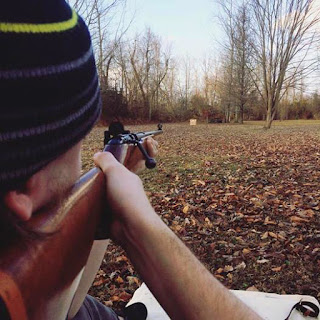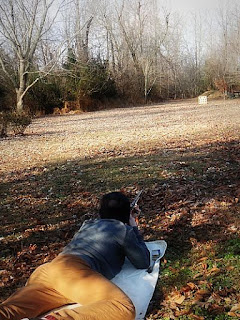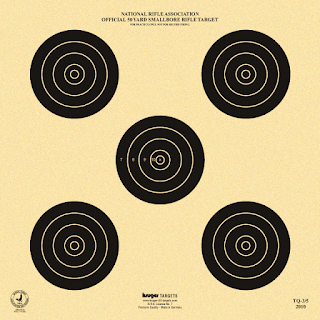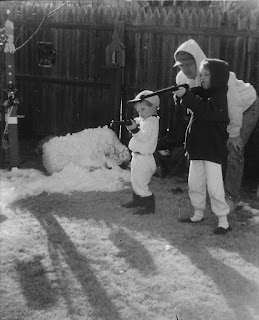The wind is always moving in Oklahoma but on rare occasions it settles into a drifting whisper. A whisper it was on that hot summer day more than 20 years ago when I drove the hour and half from Edmond to Catoosa near Tulsa to participate in a 4 position smallbore rifle shoot. It was my first time to try my shooting skills, limited as they were, against others in a friendly competition.

After signing in and moving over to my assigned booth, I felt a little embarrassed as I watched seasoned competitors remove their $1000 and even $2000 specialized target rifles from cases that cost more than my little sporting rifle. No one said anything to me, no one even cast a critical eye toward my feeble attempt to at least look like I belonged there, which I didn't. Most of the other dozen or so shooter suited up with their specialized shooting coats and gloves and rolled out their store bought shooting pads. Most of them setup their high dollar Nikon spotting scopes which allowed them to view where their shots fell on the 50 yard bullseye targets with ease. I used an old 8x pair of binoculars which were barely strong enough to do the job and only then if I set my eyes into a deep squint.
I cast envious glances at their beautifully stocked target rifles which were fitted with easily adjusted diopter target sights. A click right or left and up and down made easy work of zeroing in the sights. I had recently hired a gunsmith to replace the original v-sight on my rifle with a cheap peep sight that could only be adjusted if you used a screwdriver to first loosen the lock nuts then with another smaller screwdriver turn the adjustment screw. It took much longer to get the sight zeroed, but it worked, sort of.

I rolled out my shooting pad, a blanket, and attached the shooting sling, an old belt, to the front attachment, settled into the first position, prone, and after the range officer gave the signal, began to sight in my Montgomery Wards 22 caliber sporting rifle using CCI green label target loads. I knew in the back of my mind I stood little chance of really competing against these Olympic quality shooters and rifles, but I just wanted to see where I stood. I fired 3 shots at the sight-in target and with the binoculars noticed my pattern was tightly grouped but slightly low and to the left all inside the 8 ring. I made a quick adjustment and fired 3 more sighters. I wasn't sure where they hit as I could not discern with the binoculars any noticeable hits. The range officer called a cease fire, and we all walked out to our targets. My last three shots landed inside the 10 ring with 2 of them being 10x. I really thought I had arrived and these guys didn't stand a chance. My little old sport rifle was going to shoot rings around them...so I thought.

We went through the first round from the prone position and my steadiness of hand and the inconsistent nature of my low end rifle caused my scores to fall off some. When we returned to the shooting station we were not allowed to score our own targets, so we exchanged with the shooter next to us. I managed to score a 47 on one of the targets, and a 46 out of 50 on the other. The shooter next to me who was decked out in all the pro-style shooting gear and using one of those $1000 target rifles scored no better than I had.
When we handed our targets back to each other, he said, "Nice Shooting. What kind of rifle are you using?" I smiled rather sheepishly and said, "Oh, just that 20 year old (at the time) sporting rifle."
His eyebrow raised and he lifted my simple rifle off the table. "You shot this target with this rifle?"
"That's right," I replied.
He shook his head in disbelief and said, "Well done. Most of the shooters here with Olympic quality target rifles can't shoot that well."
As the shoot wore on through the other positions, sitting, kneeling, and standing, my lack of shooting skill and inferior equipment began to take a toll and my scores although respectable fell well short of what the others were doing. But it was a fun experience and I learned a great deal about what it really takes to become a great shooter. I returned from time to time through the summer for additional shooting experience but never really did fit in with that group...I just could not afford to purchase all the equipment I needed to be able to effectively compete.
Over the years I have spent time with my two boys teaching the basics of shooting starting first with a BB-gun and eventually graduating to the 22 and shotguns. They learned well and seemed to always enjoy those moments sighting on those targets. My youngest son eventually joined the ROTC shooting team at his high school and competed with them making it as a team all the way to the Junior Olympics. They did not win anything, but the experience was amazing for them and for him.

Target shooting requires skill sets that carry over into other parts of your life. Patience, steadiness of nerve, accuracy, practice and more practice, learning to focus, to control ones emotions, becoming one with your environment and using your mind and your body to build confidence. Even today, I will pull out that same old sporting rifle, now over 40 years old, set up some of those same 50 yard smallbore rifle targets in the backyard and launch a few rounds with my boys to see if we can shoot a tight pattern around the bulls eye.


















































